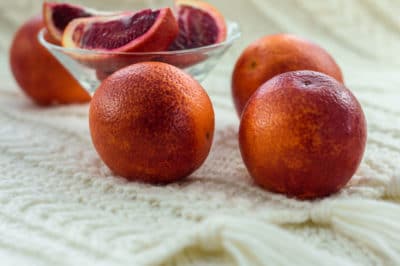Blood Oranges and Seasonal Availability
Limited availability only adds to blood oranges’ mystique. The good news is that picking season for the three most widely commercialized varieties lasts several months. At least one is usually available between December and May.
In order of ripening, the best-selling blood oranges include:
- Seedless, reddish-orange ‘Moro’ (Citrus sinensis ‘Moro’) fruit boasts deep-purple (sometimes almost black) pulp. Sweet with hints of raspberry, it ripens between early December and mid-March. It holds on the tree until April or early May, but the taste may lose its intensity.
- Teardrop-shaped ‘Tarocco’ (Citrus sinensis ‘Tarocco’) fruit — considered the sweetest blood orange — starts ripening in mid-December or January and continues into May. The red blush running through its orange pulp is most concentrated most heavily at the base.
- ‘Sanguinello’ (Citrus sinensis ‘Sanguinello’) fruit begins ripening in February, with peak harvest in April and May. Its deep-orange peel is tinged with red, and blood-red streaks run through its juicy, seedless orange pulp.
Where Do Blood Oranges Come From?
Blood oranges are a mutation of sweet oranges and have been cultivated on the Italian island of Sicily for more than a thousand years. In the beginning, only royalty was allowed to enjoy their intense sweetness and exotic coloring.
Today, most blood oranges come from Mediterranean-climate countries including:
- Italy
- Malta
- Spain
The bulk of the United States’ blood orange crop comes from California. Florida, Arizona and Texas also have some commercial growers.
Blood Oranges, Color and Cold
The mutation responsible for blood oranges’ unique color affected the gene that controls their anthocyanin content. Anthocyanins are the red, purple or blue pigments found in many fruits, but in blood oranges the gene regulating them responds to cold by shifting into overdrive.
Blood oranges become “bloody” when exposed to cold temperatures during development or after harvest. Researchers are still trying to determine how much cold exposure triggers the change.
In other words, blood orange trees will grow anywhere in USDA plant hardiness zones 9 and 10, but their fruit assumes its trademark color only in a limited part of that range. Where winters are humid and warm, a few red specks are the most it can manage.
